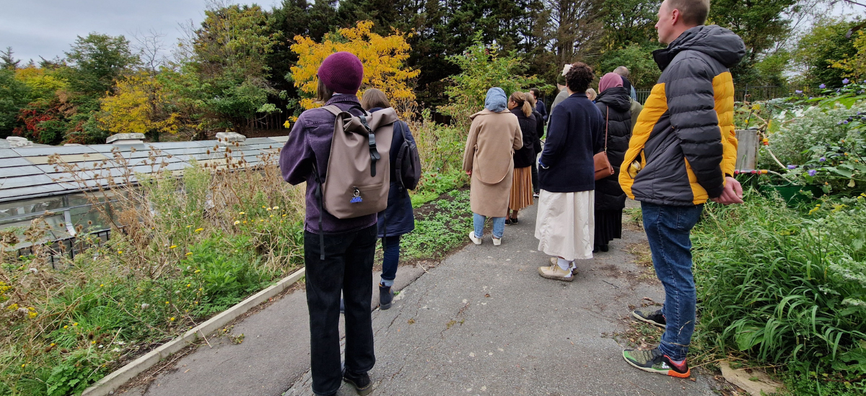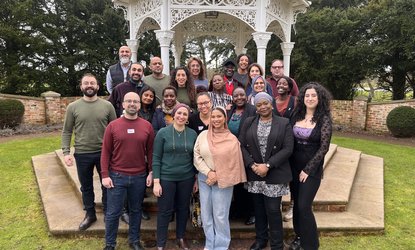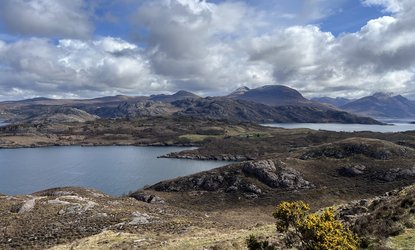Jenny Dadd, Funding Manager and Esmée's lead on our fishing in tandem with nature priority, writes about the range of work we're supporting towards healthy UK seas and thriving coastal communities.
When I started work at Esmée, the organisations we supported on nature conservation were almost entirely concentrated on nature found on land. We had a mere smattering on freshwater-focused work for UK rivers and other freshwater systems, and an almost complete absence of anything of the salty variety. Given the UK is very much made up of island nations, this struck me as odd. So we delved a bit deeper to understand what was happening.
How UK seas once teemed with life
Work by Chris Rose, an environment and communications consultant at Campaign Strategy Ltd, told us that people's perceptions of UK seas, and particularly the North and Irish seas were that these were barren places, and cold and dark. The once mighty fishing ports were places where our social change work, focused on multiple deprivation, rather than our work at the time on the environment, or how healthy UK seas could support communities.
I love a bit of history and I love the sea. Professor Callum Roberts, (now a Professor of Marine Conservation at the University of Exeter, I met him when we were both working in Yorkshire and Humber), was a great point of contact for me. He brought the real former might of UK seas to life when he came in to speak to our Trustees. One image he used, which stuck with me was pictures of giant tuna, far bigger than the fishers that had caught it, caught just off Whitby. Oh yes, back in the days of black and white photos, our seas were teeming with life. From the seabed where minute creatures act together to breathe life into the oceans, and the plankton which nurtures so much of life at sea, right through to those vast predators like bluefin tuna.
Industrialisation of fishing and pollution changed everything and left us with relatively empty seas and this overall sense of darkness. There was some light in the western part of the English Channel where Dorset, Devon and Cornish communities still felt connected to their sea and where public perceptions were brighter. Whilst those seas weren't quite teeming with life and there had been some loss of livelihoods, overall, there was more optimism and stronger links between communities and the sea.
Working with our partners, we want to restore biodiversity to our seas and enable communities that depend on them to thrive. Below, we share some of what we've been focused on, alongside what's next for Esmée.
Developing partnerships to champion and protect UK seas
We made a decision to focus on the Irish and the North Seas. Our initial support was around securing legislation in each of the nations and inspiring people to learn about and stand up for their seas. The Marine and Coastal Access Act was passed in 2009 and on the back of that followed a great deal of work focused on Marine Protected Areas and Marine Conservation Zones. Today, we are committed to the sector's call to action of 30% protected by 2030 – whether that is land or sea. In our seas, there are currently 371 Marine Protected Areas covering 38% of UK seas. If all of these were properly managed, the UK could easily achieve its target to protect 30% of UK waters by 2030. But damaging activity like bottom trawling, and sand and gravel extraction for house building and infrastructure projects still go largely unregulated, despite the designations of 'protected areas.' The need for policy and advocacy can be a long haul and it is still playing out within the UK. We helped organisations to come together to bring marine to the fore in each of the nations and we continue to support the Northern Ireland Marine Task Force (a collaboration of ten organisations) and others including the marine group at the Environment Link in each nation to work with Government, industry, communities and fishers for more prosperous seas.
One of the first regional scale projects out of the traps was a North Sea Wildlife Trusts collaboration, which Yorkshire Wildlife Trust took the brave decision to host. The North West Wildlife Trusts in England followed with a focus on the Irish Sea. These partnerships are vital in bridging communication to take in conservation at sea and to engage all ages at visitor centres to be able to learn and grow the next generation of marine champions.
Broadening Esmée’s support
Esmée's support on marine over the years has been rather tentacle like. As is standard for us, we revenue funded organisations through grants to take action on a number of fronts.
For instance:
- Sustainable consumer choice with Greenpeace
- Smaller scale fishermen whose fishing practice tends to be less damaging to nature through organisations like Scottish Creel Fishermen's Federation
- Enabling communities to protect their own waters and plan for the future through the Coastal Communities Network in Scotland
There has also been plenty of awareness raising, including with Scottish Wildlife Trust and snorkel safaris for young people which motivated them to campaign to make Ullapool the first place to ban single use plastic. We’ve also been pleased to work with Fauna and Flora International who has worked on microplastics pollution, and CHEM Trust’s work on hormone disrupting chemicals pollution in our seas.
We have seen momentum grow and focus change over this timeframe which spans more than a decade. Our own focus at Esmée is still on marine and it is why fishing in tandem with nature is one of our five key priority areas guiding our work from 2020-2025.
What next
30 by 2030 for our seas
For our part, we will continue to work with progressive marine collaborations like the North Sea Wildlife Trusts as their work expands to take in emerging interest in blue carbon.
Watch the short film below to learn more about their work.
Private investment for blue carbon
Seagrass captures carbon at a rate of 35 times more than tropical rainforests and if the huge swathes of it that used to surround much of our coastline can be restored, it makes excellent cover for juvenile species of all kinds of sea creatures, as does reefs of native oysters and mussels. A mix of an undisturbed seabed, inshore seagrass, kelp forests and bivalve reefs will take us a long way towards teeming seas and the sea as a restored climate asset in the UK. We’re interested in understanding whether learning from the development of the peatland code to enable private investment in UK peatlands can be adapted to include investment in kelp forests at sea and estuarine habitats such as saltmarsh. The role that the sea plays in a carbon context is poorly understood and private investment needs to be blue as well as green.
Fishing and coastal communities leading the way
We recognise that fishing communities have been very badly affected first by Brexit, and then Covid. We commissioned a report last year in response to the dual impacts of both on UK fisheries, and we’re now exploring the different opportunities to take forward from the recommendations.
We’re also interested in the potential of community owned aquaculture such as that happening in Loch Craignish with Seawilding. The UK’s first community-led native oyster and seagrass restoration project, they work with community groups, schools, environmental NGOs, regulatory bodies and academic partners with the aim of restoring biodiversity, sequestering carbon, and creating green jobs. Seawilding is also keen to share what they learn and support other coastal and island communities wanting to do something similar.
Watch the short film below for an introduction to Seawilding's community-led marine habitat restoration work.
Our new strategy gives us the freedom to explore areas we know little about but where we sense there is a need to make a difference. We commissioned a report on UK aquaculture to help us gain an insight into the sector, and what role we could play.
Understanding how UK seas can support nature conservation and address climate change
Data on the movement of key seabird food species such as sand eels continues to unravel the reality of the UK's climate journey. But far less is known about marine birds when they are at sea because they are hard to track. Our recent support to British Trust for Ornithology will help to unravel seabird behaviours beyond the breeding season.
The planning system on land attracts close scrutiny, but that at sea is very different. Wind and other renewable sources of power are not opposed by anyone, but the infrastructure required is vast and has impacts on nature which need to be mitigated against. Enabling industry and the Crown Estate to interact with nature conservation interests is key to a just transition for energy, nature and people.
What more could we do?
We hope we have helped more funders to understand the role that UK marine plays in the wider nature conservation and climate jigsaw. Marine still receives less attention than its terrestrial sister and this is always likely to be the case because it is 'out of sight' for many. But the dial has shifted and we are proud of the role that Esmée has been able to pay to date.
We want to build on this work, working together with conservationists, fishers and local communities to support the recovery of UK seas – not just for the wildlife that calls it home, but for people too. If you have any ideas or opportunities to help with this, so send us an email. And if you’d just like to share feedback on this work, we’d love to hear it.
Learn more about what we want to achieve in our fishing in tandem with nature priority.






